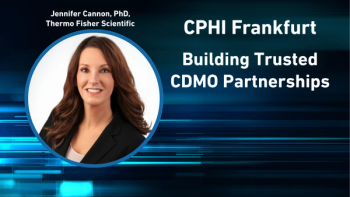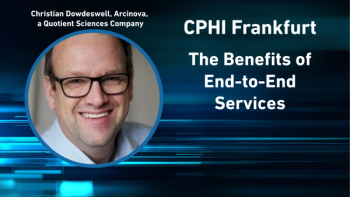
- Pharmaceutical Technology-08-01-2018
- Volume 2018 Supplement
- Issue 3
How to Address Roadblocks During Technology Transfer: A CDMO’s Perspective
Real-life examples illustrate how to reduce the risks for each transferring partner and ensure that the development process meets regulatory requirements.
Technology transfer can be a daunting and high-risk task. A technology transfer of a commercial aseptic manufacturing process is much like the introduction of a product to a new manufacturing facility. The process of achieving an exchange of information that leads to a successful execution and quality manufacturing of a drug product involves numerous steps and challenges. The stakes are high, and the processes involved are complex. Strict regulatory requirements and attention to detail are required to achieve success. The goal of technology transfer activities is to transfer product and process knowledge between development and manufacturing, and within or between manufacturing sites to achieve project realization. This knowledge forms the basis for the manufacturing process, control strategy, process validation approach, and ongoing continual improvement.
The necessities of a successful technology transfer
As with any complex and intricate action, planning and execution for a technology transfer is critical. It begins with the creation of a team that has the necessary skill sets and amount of know-how in addressing multiple areas of the process. A dedicated technology transfer team includes experts from development, production, quality assurance, regulatory affairs, quality control, and qualification/validation, among others. Together, they are responsible for facilitating and executing the process and coordination with the technology transfer/project leader. Roles and responsibilities for all team members of the facility involved must be agreed upon, and a system that enables adequate communication and feedback of information, including a confidentiality agreement between parties, established.
From a regulatory perspective, a technology transfer of an aseptic commercial product from one cleanroom to another may not much differ in time and effort compared to initial development and design of the manufacturing process. Thus, the scope of such a transfer is determined by multivariable aspects, including:
- Filing strategies
- Special arrangements with authorities
- The commitment in accepting potential operational and methodical changes enabling the achievement of state of the art.
Commercial transfers can take more than one year; not only because of a regulatory change and the potential risk of facing unforeseen new challenges, but also because it takes time for regulatory bodies to accept the approach and be convinced that there are no impacts to the specified quality attributes.
Drivers for a technology transfer
For many pharma and biotech companies, a back-up strategy is necessary for risk management to provide an adequate supply for the patient. The firm may also lack the appropriate resources/capacity for process optimization, commercial production, secondary packaging, supply chain management, and scale-up from clinical production to larger commercial production. The best approach to enable a successful outcome is usually through working with a contract development and manufacturing organization (CDMO) that has considerable experience in technology transfer. A skilled CDMO can also help create a lifecycle management plan in the event of a change of packaging to support patient convenience or improvement of the manufacturing process.
Challenges for the CDMO
Technology transfer is one of the most complex and time-consuming processes for a CDMO, especially because multiple partners and sites are involved. On one hand, there is the sending unit, defined as the involved disciplines within the organization where a designated product, process, or method is expected to be transferred from; and on the other hand, there is the receiving unit, which are the involved disciplines at an organization where a designated product, process, or method is expected to be transferred and executed.
A successful transfer of a manufacturing process is based on appropriate relevant documentation and on the application of risk management elements according to the International Council for Harmonization (ICH) Q8 guideline (1). The existing knowledge gained from the development of the drug product and the experiences of the manufacturing process have already identified the critical quality attributes (CQAs) that must be controlled and tested to achieve the target product profile (see Table I). Therefore, the following activities are major elements of a tech transfer to achieve a robust, reproducible manufacturing process at the receiving site:
- Combination of gap and risk analysis to assist in identifying and evaluating any differences between transfer sites that have potential impact on CQAs, to identify any process steps that become critical process parameters (CPPs) that may have not been obvious on the first level of information.
- Process design at the receiving site to accommodate the known and new identified CPPs that must be controlled to meet CQAs.
- Process qualification to verify that the process enables constant quality and to establish a control strategy at the receiving site. Identifying and controlling sources of variability in material and processes is also crucial to successful technology transfers.
Additionally, knowledge of filing strategies is essential, because some countries have specific requirements for commercialization that can influence the scope of process qualification strategies, such as bracketing strategies, batch sizes, or holding times. Regulatory constraints can also influence the change of a production environment. Further, the exchange of processes including equipment and facilities, cleaning and sterilizing procedures, input parameters, and in-process controls all within, or between, production sites must be assessed, and documentation of the transfer with all its contracts, protocols, reports, and instructions must be completed. In-process and release specifications of the product must be adhered to and be comparable with the design space (i.e., the tolerance levels for specific parameters that still guarantee product quality). For the CDMO, every transfer must result in as little change as possible in order to use the existing data and simplify the regulatory approval process.
Navigating the roadblocks for successful technology transfers
As previously discussed, many roadblocks to a successful technology transfer exist, many of which commonly occur in the beginning of the transfer. The following examples help to illustrate three such situations encountered by a CDMO in technology transfer processes and how they were successfully resolved.
In the first example, based on a paper-based gap analysis, both cleanroom processes were analyzed for preparation of primary packaging materials-washing and siliconization of the glass barrels, the kind of silicone oil and mode of siliconization, number and orientation of glass barrels per container, sterilization etc.-prior to entering the filling line. In this example, two issues were identified, in the existing cleanroom-a high degree of silicone oil droplets in the solution and high variation in break-loose and glide forces. Based on the gap analysis, it was determined that compared to the old cleanroom using a wipe down siliconization technique, a spray siliconization was needed in the new cleanroom.
Switching to spray siliconization required the use of silicone oil with a lower viscosity. By using specific analytical methods, such as reflectometric interference spectroscopy, the silicone oil distribution within the glass barrel was optimized, and the glide force was further analyzed as were the corresponding volumes of silicone oil needed to guarantee the quality and to maintain the functionality of the product produced with the new cleanroom process. Because this change in silicone oil viscosity and in the level of residual silicone oil had regulatory consequences, new stability and compatibility studies had to be submitted and adapted.
In the second example, following the relevant attributes derived from the drug product specification including appearance, particulate matter, impurity, sterility, as well as extractable volume, potential risks around the compounding, mixing, and filtration processes were identified. Although this is not unusual given that additional API is necessary to manufacture more batches, larger compounding equipment was needed. As such, lab trials were undertaken to support the selection of the appropriate operational parameters. Besides the change in volume, there was also a need to analyze pumping parameters because greater volume and implemented changes created the need for more time in the filling process and, consequently, in holding times. As a precaution, the filling operation took place under nitrogen pressure to minimize any potential interaction with oxygen. The degree of oxygen sensitivity in the head space of syringes is in most cases not known, thus not defined as a specification. To maintain the current level of oxygen, additional engineering runs in both cleanrooms were required to compare the efficacy of the nitrogen flush. At the end, a modification of the new filling line was required to achieve the required low oxygen level. Although engineering runs have the disadvantage of additional cost and time, as well as a higher consumption of material, their benefits are many and include gaining a greater process understanding and performance while simultaneously training personnel in operations that take place in cleanroom conditions, the demonstration of product comparability, and the verification of CQAs, among others. Further, the risk mitigation efforts can be demonstrated, and any issue or manufacturing instruction can be improved. In this example, the measures to ensure equal product quality ultimately involved the partial reconstruction of a station in the filling line to improve the nitrogen flush.
The third example involved the compounding process. In this example, there existed an incompatibility between the donor organization, which used only glass material, and the receiver organization, which used a disposable bag and stainless-steel container instead of glass. Without knowing the impact on the product given a change in the material, a compatibility lab trial had to be initiated to determine the selection of the appropriate material, in this case, the use of disposable bags; results are shown in Figure 1, where it was observed that disposable bags had similar outcomes compared with the glass container from the donor organization.
Knowing the right people
Technology transfer can only be considered successful if the receiving unit can reproduce the transferred product, process, or method against a predefined set of specifications as agreed with the sending unit of the drug. To achieve this level, a project is largely dependent on the skill and performance of individuals assigned to the project, as well as on the experience of the transferring team. The experience of the receiving unit in terms of the drug product, primary packaging, process, and components is extremely important as the initial gap analysis is paper based. Further documentation is a key element of technology transfer, enabling consistent and controlled procedures for technology transfer and to run the process. Clear documentation should provide assurance of process and product knowledge.
Finally, when choosing a CDMO as an outsourcing partner, one must ensure that the company offers a detailed gap analysis for your transfer and can offer significant experience and analytical methods for process design and development. The execution of risk analysis requires experts to identify the relevant degree of detail; therefore, it is important that the appropriate individuals are involved from the start.
Reference
1. ICH Q8, Pharmaceutical Development (Geneva, August 2009).
Article Details
Pharmaceutical Technology
Vol. 42
August 2018
Pages: s30–s33
Citation
When referring to this article, please cite it as B. Hinneburg, “How to Address Roadblocks During Technology Transfer: A CDMO’s Perspective,” Pharmaceutical Technology Outsourcing Resources Supplement (August 2018).
About the Author
Baerbel Hinneburg, PhD, is Director Technology & Process Transfer at Vetter.
Articles in this issue
over 7 years ago
Classifying Potent and Highly Potent Moleculesover 7 years ago
Designing Combination Productsover 7 years ago
CMO Roundup: Expansions for Biomanufacturingover 7 years ago
Small-Molecule Contract Services Updateover 7 years ago
What Ifs in the Five-Year Planover 7 years ago
Reducing Cleanroom Complexities and Costover 7 years ago
Pharmaceutical Technology, 2018 Outsourcing Resources (PDF)Newsletter
Get the essential updates shaping the future of pharma manufacturing and compliance—subscribe today to Pharmaceutical Technology and never miss a breakthrough.




